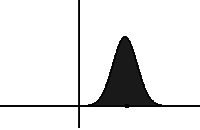Fokker–Planck equation
by gowtham[ Edit ] 2010-02-16 19:17:42
The Fokker–Planck equation describes the time evolution of the probability density function of the position of a particle, and can be generalized to other observables as well.[1] It is named after Adriaan Fokker and Max Planck and is also known as the Kolmogorov forward equation, named after Andrey Kolmogorov. The first use of the Fokker–Planck equation was for the statistical description of Brownian motion of a particle in a fluid. The first consistent microscopic derivation of the Fokker–Planck equation in the single scheme of classical and quantum mechanics was performed[2] by Nikolay Bogoliubov and Nikolay Krylov.[3]
In one spatial dimension x, the Fokker–Planck equation for a process with drift D1(x,t) and diffusion D2(x,t) is
\frac{\partial}{\partial t}f(x,t)=-\frac{\partial}{\partial x}\left[ D_{1}(x,t)f(x,t)\right] +\frac{\partial^2}{\partial x^2}\left[ D_{2}(x,t)f(x,t)\right].
More generally, the time-dependent probability distribution may depend on a set of N macrovariables xi. The general form of the Fokker–Planck equation is then
\frac{\partial f}{\partial t} = -\sum_{i=1}^{N} \frac{\partial}{\partial x_i} \left[ D_i^1(x_1, \ldots, x_N) f \right] + \sum_{i=1}^{N} \sum_{j=1}^{N} \frac{\partial^2}{\partial x_i \, \partial x_j} \left[ D_{ij}^2(x_1, \ldots, x_N) f \right],
where D1 is the drift vector and D2 the diffusion tensor; the latter results from the presence of the stochastic force.

